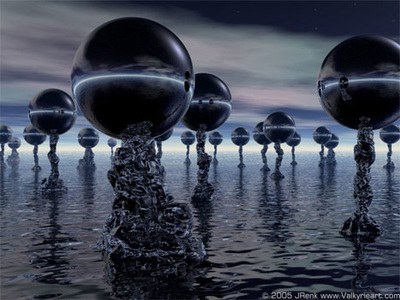The interviewer looks disappointed. "But this is a time travel, isn't it?"
"Well, yes. But it takes place—"
"No world building? That's too bad," the interviewer says.
"Wait, wait. You don't understand..." I cry as the interviewer walks away. Darn!

BUILDING A BRAVE NEW WORLD
Most people define world building as the construction of an imaginary world but, in fact, all writers deal with world building. It's a necessity if a writer hopes to produce a novel, in any genre, that is consistent, real, and believable.
Creating the setting of a novel is a type of world building. Novels set in contemporary times and in familiar places don't require as much time, research, or as many words. A writer often sets the stage in a few words or sentences. That's all the reader needs to understand where and when the novel takes place, how people dress and act, and the laws of physics that apply. The reader can rely on what he/she knows of that time and place and the planet we live on.
Despite the advancements in communication, the world is still a big place. Even though we all have many things in common, such as cell phones and automobiles, there are still differences -- accents, language, customs, dress, food, climate, housing -- just to name a few. Even if your novel is contemporary, you need to pinpoint those things that are different about the particular setting. But there won't be any big surprises.
Isn't writing a historical about rebuilding the world that existed in a specific time and place on earth? More differences will exist, and you can't have a Roman soldier wearing a wrist watch or using modern slang; but still, no big surprises.
So, contemporary and historical require some world building, but you can always count on one moon in the sky, gravity, rotation of the earth around the sun, ocean tides, and human nature. The laws of physics are the laws of physics, even in a time when they weren't understood.

When a writer takes on science fiction, fantasy, or time
travel (depending on where the traveling is to or from)
all bets are off. These genres take more time, research,
and words to create a world which the reader understands.
"Why do I need research? This is fantasy. I can make up what I want."
The key to world building is making your story believable. Even though the author is writing the rules of this new world, there still have to be rules … and the author has to follow them. And as the author, you have to know, at least generally, those rules that exist in our universe in order to decide which of them you're going to break when you create the new one.
"CONSTRUCTION MANUAL"
Although there are no "construction manuals" on how to build a new world, many authors offer sound advice on the approach. Author Holly Lisle suggests there are three varieties of writers in relation to world building for fantasy and science fiction genres.
"Those who really have no idea what world building is or why they should bother with it."
"Those who do know, but figure they'll wing the details as they go." and
"Those obsessive folks who secretly believe that they can't start a book until the whole
planet is in place."
My preference and the general recommendation of most of the writers on this subject is: Don't do too much at the beginning. Focus on putting the big ticket items (the core principles, as Victoria Strauss puts it) in place and develop a solid concept, then deal with the more detailed issues when they come up. Deal only with the parts of the world you need for the plot of your story.
● Develop a well-thought-out concept of your world.
In order for readers to visualize the world, it has to come alive in the writer's mind. It has to feel tangible and real to the writer before it can be tangible and real to the reader. There are tricks to do that, including drawing maps of the world and figuring out the geography.
● Develop the Core Principles.
● Anchor the world with humanity and things human that the reader knows.
Even if this is a Star Wars type world not based on humanity or our universe, your readers are human. Where is doesn't matter to the storyline, ground the story in earth, humanity or things that readers are familiar with, like an equivalent for coffee, booz, or expected human reactions.
An example given by A. Wrighton is that in the movie Star Wars, which is not related to earth in history or development, still has a senate. People know what a senate is. You could call it a derfloppengut, but senate works just fine. Don't make the world any more complicated than necessary.
● Don't overwhelm the reader with too much
Don't explain everything up front in the first chapter. And, of course, the author should show the reader, rather than explain.
● Establish the basic rules and make the limitations seem real
Because fantasy and science fiction ask readers to suspend disbelief, the work needs to be consistent internally or the reader loses faith in the author. Like any novel, something can change … but only if there is a credible reason. Most readers will spot the inconsistencies and be jarred out of the story.
● Know history, ours and that of the imaginary world
Is any part of the story based on real history, or is this an alternate world? A fantasy with magic in it could easily be set on the earth and be subject to real history … or it could be on earth, but with a completely different history. If you are using real historical events, they better be correct within the rules of the new world. And, of course, the rules need to be clear.
You don't have to overdo it at the beginning and know everything about the world, but do your prep work. Without it, you can paint yourself into a corner with no way out that doesn't break the rules of your new world.
Rebecca Zanetti lists the following five blunders in world building:
● "Making the world faaar too complex right at the beginning
Avoid trying to explain everything up front in an information dump."
● "Forgetting to look ahead and giving all the rules in book one, leaving no wiggle room in the next book."
● "Forgetting even the characters may be new to the world and should react believably to the strange new world."
● "Forgetting to relate the world to the one the readers live in.
Even paranormal creatures need humanistic flaws, goals, weaknesses. Give the readers something to hold on to that they understand."
● "Holding ourselves back and not putting bizarre ideas out there."
Rebecca says she writes every scene like she's the only person who is ever going to read it.
A FEW WORDS ABOUT WORDS
Not only can you create your own species, strange sentient life forms, and wild beasts that fly, you can also create a language or languages to be spoken in this new universe. But be careful. The people who read your work speak English (or another earth language). They won't want to learn a whole new one — which most of us aren't capable of creating anyway — just to read your fantasy novel.
Tip the reader off that the characters are speaking another language, but use made-up, new-universe words sparingly, just as you would to give the flavor of a foreign language or an accent without making the dialogue unreadable. Here's a line from my sci-fi romance All In The Game.
The voice sounded familiar. So did the language, but not the English Shauna knew.
A strange, stilted dialect. Yet, she understood perfectly.
An A. Wrighton example of the same thing.
Dref rubbed his antennae and sighed. He looked at his mother and spoke to her in their
native Huvlovian tongue, the only way he knew how – while whining.
I suggest limiting the number of words in your new or futuristic language, and explaining them (preferably, showing the reader what they refer to) the first time used. After that, the reader has to remember. Or you can put in a glossary of words at the back.
PUT THIS ISSUE ON YOUR RADAR SCREEN.
Resources for World Building
http://awrighton.com/2013/03/14/world-building-for-fantasy-sci-fi-writers/
http://rebeccazanetti.com/writing-craft/five-blunders-authors-make-in-world-building/
http://www.stormthecastle.com/mainpages/for_writers/worldbuilding.htm
http://www.victoriastrauss.com/advice/world-building/
https://en.wikipedia.org/wiki/Worldbuilding
http://hollylisle.com/how-much-of-my-world-do-i-build/
http://www.stormthecastle.com/mainpages/for_writers/how-to-write-an-epic-fantasy-novel.htm
http://www.sfwa.org/2009/08/fantasy-worldbuilding-questions/
http://www.lsswritingschool.com/WorldBuilding.html
http://www.cjbrightley.com/on-writing-and-publishing/world-building-for-fantasy-authors/
http://www.lisahartjes.com/tips-for-world-building-when-writing-fantasy-and-science-fiction/
http://www.blackholly.com/writingresources.html
http://sffworlds.wordpress.com/2013/05/22/world-building-for-writers-build-more-than-you-need/
http://worldsoftheimagination.wordpress.com/tag/world-building-for-writers/
http://referenceforwriters.tumblr.com/post/47088714715/worldbuilding
http://www.writersdigest.com/tip-of-the-day/discover-the-basic-elements-of-setting-in-a-story
□









 RSS Feed
RSS Feed